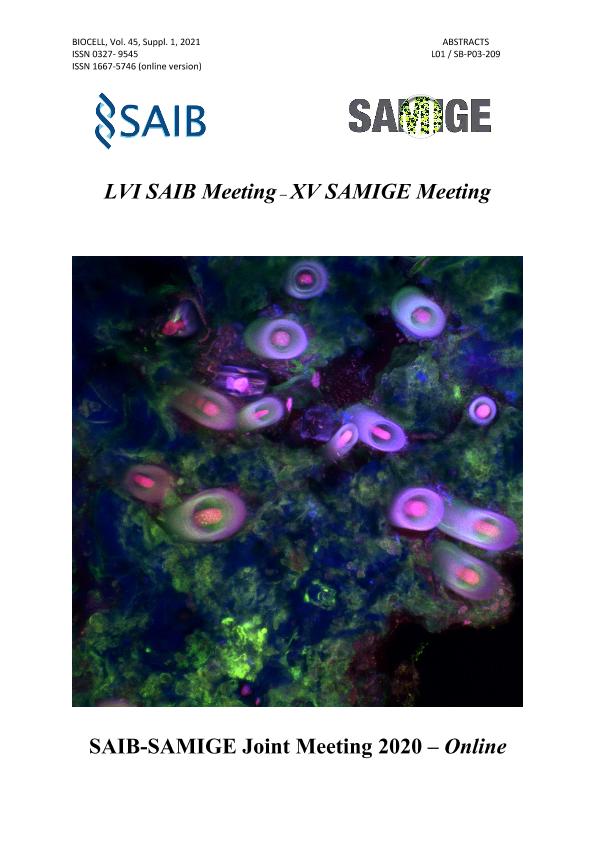Evento
Functional fermented beberages enriched in seleno-amino acids and seleno-nanoparticles
Martínez, Fernando Gabriel ; Moreno Martin, Gustavo; Madrid Albarrán, Yolanda; Ordoñez, Omar Federico
; Moreno Martin, Gustavo; Madrid Albarrán, Yolanda; Ordoñez, Omar Federico ; Pescuma, Micaela
; Pescuma, Micaela ; Mozzi, Fernanda Beatriz
; Mozzi, Fernanda Beatriz
 ; Moreno Martin, Gustavo; Madrid Albarrán, Yolanda; Ordoñez, Omar Federico
; Moreno Martin, Gustavo; Madrid Albarrán, Yolanda; Ordoñez, Omar Federico ; Pescuma, Micaela
; Pescuma, Micaela ; Mozzi, Fernanda Beatriz
; Mozzi, Fernanda Beatriz
Tipo del evento:
Reunión
Nombre del evento:
LVI Annual Meeting of the Argentine Society for Biochemistry and Molecular Biology Research; XV Annual Meeting of the Argentinean Society for General Microbiology
Fecha del evento:
02/11/2020
Institución Organizadora:
Sociedad Argentina de Investigación en Bioquímica y Biología Molecular;
Sociedad Argentina de Microbiología General;
Título de la revista:
Biocell
Editorial:
Tech Science Press
ISSN:
0327-9545
e-ISSN:
1667-5746
Idioma:
Inglés
Clasificación temática:
Resumen
Selenium (Se) is an essential micronutrient for human health, which is found as selenocysteine (SeCys) in the active site of Se-dependent enzymes involved in the response to oxidative stress and in thyroid functions. The main inorganic Se forms, selenite and selenate are toxic. Some lactic acid bacteria (LAB) can reduce Se salts into seleno-nanoparticles (SeNPs) and seleno-amino acids, which are non-toxic and highly bioavailable forms. In several European countries, as well as in Argentina, Se intake is below the recommended dietary intake (RDI). Se-enrichment of foods is an attractive strategy to increase its ingestion. We aimed to formulate a fermented fruit juice-milk beverage (FJMB) bio-enriched in Se. The fruit-origin strains Fructobacillus tropaeoli CRL 2034 and Levilactobacillus brevis CRL 2051 were grown with or without 5 mg/L of Se prior to co-inoculation (1% of each strain) in the FJMB and were incubated 14 h at 30 °C. The survival of the strains under storage conditions (6 °C, 52 days), and after digestion [using an in vitro gastrointestinal system (GIS)] was analyzed. The strains grew (up to 8.6 U log each) and acidified FJMB reaching a final pH of 4.6. Sugar metabolism and organic acid production were similar for control and selenized cells (RP-HPLC); while mannitol production by selenized cells of the Fructobacillus was lower (0.18 ± 0.03) than control cells. The studied strains could not degrade the proteins present in the FJMB (SDS-PAGE). Selenized cells increased the beverage total Se concentration (ICP-MS, 84.9 ± 4.5 μg/L) and biotransformed selenite into SeCys (39.1 ± 0.4 μg/L) and SeMet (6.1 ± 0.1 μg/L) as detected by LC-ICP-MS. Moreover, SEM images of the fermented FJMB revealed the presence of SeNPs attached to the cell surface of both strains. Interestingly, microbial resistance at the end of the shelf life was greater (between 0.5 and 0.7 U log) for selenized than non-selenized cells. However, no differences were observed in the sugar and organic acid concentrations between treated and non-treated cells and a lower (0.29 ± 0.04 g/L) mannitol production was detected at 28 day incubation by the treated strains. After GIS digestion, a decrease in the cell counts of F. tropaeoli and L. brevis (1.60 and 0.80 U log, respectively) was observed. Interestingly, 64.3 ± 3.3 μg total Se/L partly as SeCys (25.8 ± 2.3 μg/L) and SeMet (2.4 ± 0.2 μg/L) were found in the FJMB supernatant after intestinal digestion, highlighting the bioaccessibility of these compounds. Remarkably, 250 mL of the FJMB could cover 64% of the Se RDI (25 μg/day), from which 28% is composed by seleno-amino acids. Our results suggest that selenized cells of F. tropaeoli CRL 2034 and L. brevis CRL 2051 could be used for formulating functional Se-enriched beverages to improve this micronutrient intake in humans.
Archivos asociados
Licencia
Identificadores
Colecciones
Eventos(CERELA)
Eventos de CENTRO DE REFERENCIA PARA LACTOBACILOS (I)
Eventos de CENTRO DE REFERENCIA PARA LACTOBACILOS (I)
Citación
Functional fermented beberages enriched in seleno-amino acids and seleno-nanoparticles; LVI Annual Meeting of the Argentine Society for Biochemistry and Molecular Biology Research; XV Annual Meeting of the Argentinean Society for General Microbiology; Virtual; Argentina; 2020; 78-78
Compartir



